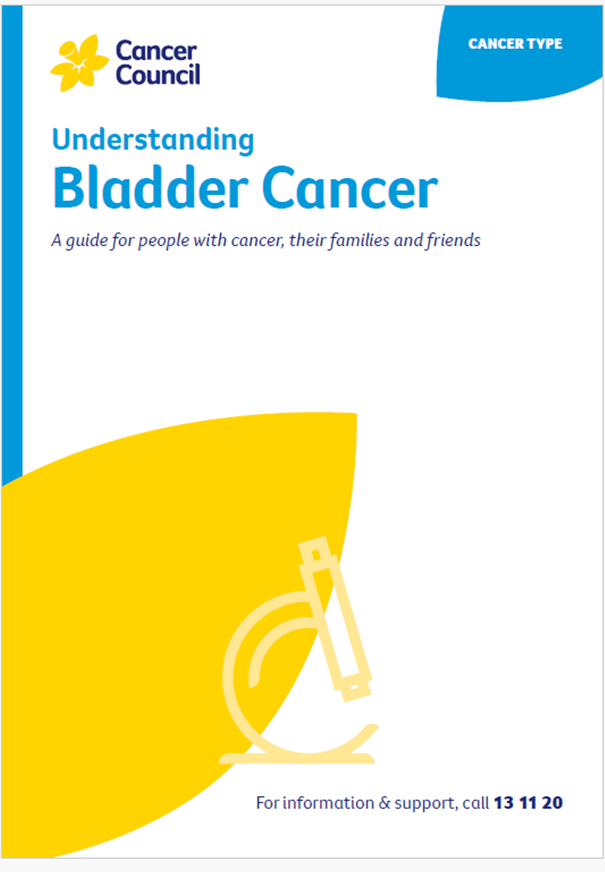- Home
- Bladder cancer
- Diagnosis
- Tests
- Further tests
Further tests for bladder cancer
You may need other imaging tests such as a radioisotope bone scan, x-ray or PET–CT scan to show if and how far the cancer has spread.
Learn more about:
Radioisotope bone scan
| What is it? | A radioisotope scan is used to see whether the cancer has spread to the bones. It may be called a whole-body bone scan (WBBS) or a bone scan. |
| What happens before the scan? | Before you have the scan, a tiny amount of radioactive dye is injected into a vein, usually in your arm. You will need to wait for a few hours while the dye moves through your bloodstream to your bones. |
| What happens? | The dye collects in areas of abnormal bone growth. Your body will be scanned with a machine that detects radioactivity. A larger amount of radioactivity will show up in any areas of bone affected by cancer cells. |
| How long does it take? | The scan is painless and takes less than an hour. Afterwards, you need to drink plenty of fluids and urinate frequently to flush the radioactive dye from your body. This usually takes a few hours. You should avoid being around young children and pregnant women for the rest of the day. |
X-rays
You may need x-rays if a particular area looks abnormal in other tests or is causing symptoms. A chest x-ray can check the health of your lungs and look for signs the cancer has spread. Sometimes, people will have a CT scan instead of an x-ray.
PET-CT scan
| What is it? | A PET (positron emission tomography) scan combined with a CT scan is a specialised imaging test. It can sometimes be used to find bladder cancer that has spread to lymph nodes or other areas of the body that may not be picked up on a CT scan. |
| What happens before the scan? | Clinic staff will tell you how to prepare for a PET–CT scan, particularly if you have diabetes. Before the scan, you will be injected with a glucose solution containing a small amount of radioactive material. Cancer cells show up brighter on the scan because they take up more glucose solution than normal cells do. |
| What happens? | You will be asked to sit quietly for 30–90 minutes as the glucose moves through your body, then you will be scanned. |
| How long does it take? | It will take several hours to prepare for and have the PET–CT scan. |
→ READ MORE: Staging and prognosis for bladder cancer
Podcast: Tests and Cancer
Listen to more of our podcast for people affected by cancer
More resources
Dr Prassannah Satasivam, Urologist and Robotic Surgeon, Epworth Hospitals and Cabrini Hospitals, VIC; Donna Clifford, Urology Nurse Practitioner, Royal Adelaide Hospital, SA; Marc Diocera, Genitourinary Nurse Consultant, Peter MacCallum Cancer Centre, VIC; Dr Renee Finnigan, Radiation Oncologist, Gold Coast University Hospital, QLD; Lisa Hann, 13 11 20 Consultant, Cancer Council SA; Dr Andrew Hirschhorn, Director of Allied Health and MQ Health Academy, MQ Health, Macquarie University, NSW; Anne Marie Lyons, Stomal Therapy Nurse, Concord Hospital and NSW Stoma Limited, NSW; John McDonald, Consumer; Prof Manish Patel, Urological Cancer and Robotic Surgeon, Westmead Hospital, Macquarie University Hospital, and The University of Sydney, NSW; Dr Jason Paterdis, Urological Surgeon, Brisbane Urology Clinic, QLD; Graeme Sissing, Consumer; Prof Martin Stockler, Medical Oncologist, The University of Sydney, Concord Cancer Centre, and Chris O’Brien Lifehouse RPA, NSW.
View the Cancer Council NSW editorial policy.
View all publications or call 13 11 20 for free printed copies.

